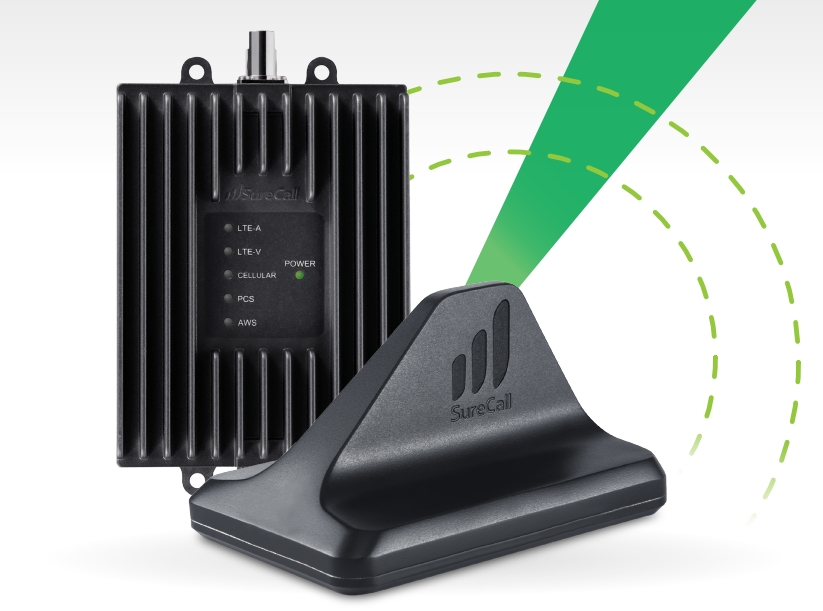Fusion2Go™ Max
Vehicle Voice and 4G Data Signal Booster
User Manual

How It Works
The SureCall Fusion2Go Max is a high-quality bidirectional booster that enhances cellular signals for vehicles.
The Fusion2Go Max works with two antennas:
- An inside antenna that communicates with your cell phone.
- An outside antenna that communicates with the cell tower.
Signals sent from a cell tower are received by the outside antenna, amplified by the booster and then sent to your cell phone via the inside antenna. When your phone transmits, the signal is sent to the inside antenna, and then sent to the cell tower via the outside antenna.
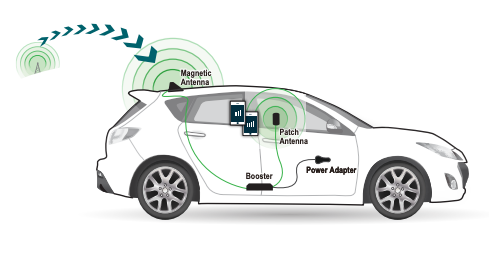
Package Contents
SureCall offers many accessories to customize your signal booster kit to your specific needs. To learn more about these accessories or to replace damaged or missing items contact your reseller.
For exchanges or returns, your reseller may request original packaging and basic product information. Turn over the signal booster and record the model and serial number for easy reference:

Your Fusion2Go Max signal booster package includes the following items:
- One outside magnetic mount antenna
- One SureCall Fusion2Go Max signal booster
- One inside patch antenna
- DC power adapter

Step 1: Attach Outside Antenna to the Vehicle’s Roof
Attach the Outside Antenna to the roof of your vehicle and at least 12-inches away from obstructions and other radiating elements, like other antennas.
Suggestion: For non-metal or non-magnetic vehicle surfaces use the optional adhesive tape.
Next, run the cable from the outside antenna across the car’s roof and into the car. To hide and protect the antenna cable, carefully pull down the door seal, run cable underneath it and push the seal back into place. Run the cable to the inside of the vehicle near the planned location of the booster (under the seat of the vehicle, or in the front or middle console).
Note: The outside antenna must not be collocated or operating with any other antenna or booster.

Step 2. Install the Inside Patch Antenna
Identify a location for the inside antenna on or near your front dashboard that is
- Within 2-3 feet of the typical cell phone location
- At least 8 inches (20cm) from cellular devices and
- At least 4 inches (10cm) from metal
Next, peel Velcro backing and apply to a clean dry surface in your chosen location.

Step 3. Place Booster and Connect Cables
Select a well-ventilated location for the booster that is away from excessive heat, direct sunlight, and moisture. We often suggest installing beneath a seat or within the front console.
Connect the cable from the outside antenna to the connection marked OUTSIDE and connect the cable from inside patch antenna to the connection marked INSIDE. Tighten the connections and wrap up any loose cable.

Step 4. Connect Power
Connect the power cord connector to the signal booster and insert the other end into your cigarette lighter adapter1 . The Power LED illuminates to show that the signal booster is ready for use. The Alert LEDs flash 5 times to show the frequency band is operational.
Place a call in a location you have previously experienced poor signal and confirm that your phone is receiving a boosted signal.
Note: When your car is off, turn the power switch to OFF to keep the booster from continuing to draw power from your vehicle.

[1] WARNING: The booster is rated for 5-15V input voltage. DO NOT use the booster with a higher voltage power supply. This can damage the booster and/or cause personal injury
LED Indicators
Place a call in a location you have previously experienced poor signal and confirm that your phone is receiving a boosted signal. Normal operation is indicated by Green LEDs (both flashing and solid). In the event Red LEDs appear, antenna adjustments may be needed.
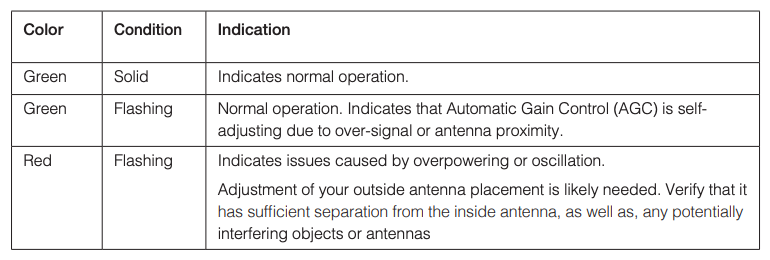
Note that the booster case may become warm during operation. This is normal.
Troubleshooting
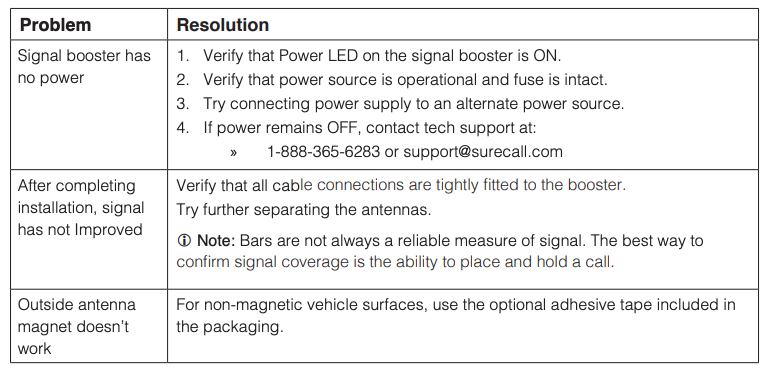
* WARNING: The booster is rated for 5-15V input voltage. DO NOT use the booster with a higher voltage power supply. This can damage the booster and/or cause personal injury.
Specifications
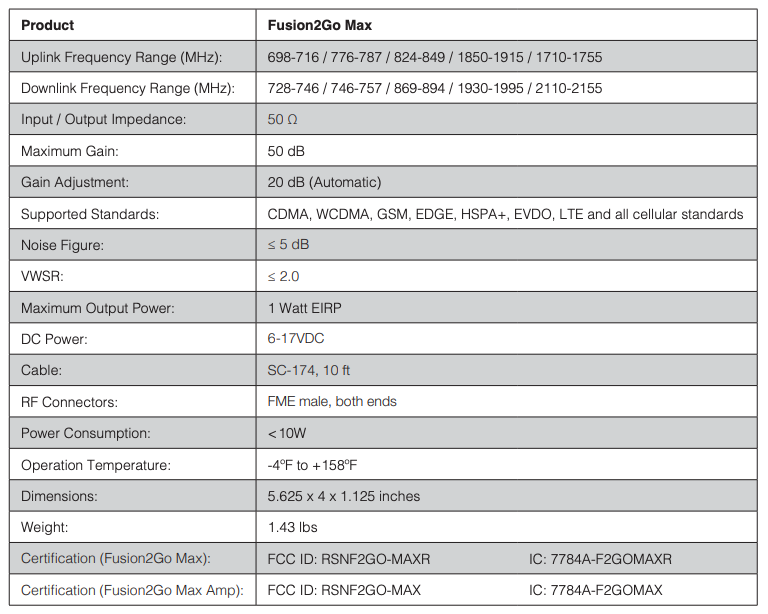
Note: The term “IC” before the radio certification number only signifies that Industry Canada technical specifications were met.
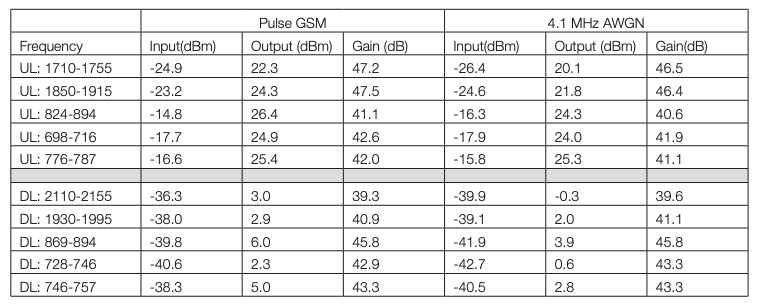
Note: The booster went into Transmitter off mode at Max input power in accordance with section 5.5. Results presented on the above table are at 1 dB below the Transmit off RF input level.
Warning: Unauthorized antennas, cables, and/or coupling devices are prohibited by FCC new rules. Changes or modifications not expressly approved by SureCall could void the user’s authority to operate the equipment.
FCC 27.50(d)(4) Statement: Fixed, mobile and portable (hand-held) stations operating in the 1720-1755 MHz band are limited 1 Watt EIRP. Fixed stations operating in this band are limited to a maximum antenna height of 10 meters above ground. Mobile and portable stations operating in this band must employ a means for limiting power to the minimum necessary for successful communications.
When used with any mobile device utilizing the 1710-1755 MHz band, the FCC limits booster equipment placement to a maximum of 10 meters above ground level. Installation of this equipment which does not comply with federal requirements may subject the owner to FCC enforcement action
15.105 This equipment has been tested and found to comply with the limits for a Class B digital device, pursuant to part 15 of the FCC Rules. These limits are designed to provide reasonable protection against harmful interference in a residential installation. This equipment generates, uses and can radiate radio frequency energy and, if not installed and used in accordance with the instructions, may cause harmful interference to radio communications. However, there is no guarantee that interference will not occur in a particular installation. If this equipment does cause harmful interference to radio or television reception, which can be determined by turning the equipment off and on, the user is encouraged to try to correct the interference by one or more of the following measures:
- Reorient or relocate the receiving antenna
- Increase the separation between the equipment and receiver.
- Connect the equipment into an outlet on a circuit different from that to which the receiver is connected
- Consult the dealer or an experienced radio/TV technician for help.
15.19 This device complies with Part 15 of the FCC Rules. Operation is subject to the following two conditions: (1) this device may not cause harmful interference, and (2) this device must accept any interference received, including interference that may cause undesired operation.
Antenna Kitting Information

Consumer Guidelines
This is a CONSUMER device
BEFORE USE, you MUST REGISTER THIS DEVICE with your wireless provider and have your provider’s consent. Most wireless providers consent to the use of signal boosters. Some providers may not consent to the use of this device on their network. If you are unsure, contact your provider. In Canada, BEFORE USE you must meet all requirements set out in ISED CPC-2-1-051
You MUST operate this device with approved antennas and cables as specified by the manufacturer. Antennas MUST be installed at least 20 cm (8 inches) from (i.e. MUST NOT be installed within 20 cm of) any person.
You MUST cease operation of this device immediately if requested by the FCC (or ISED in Canada) or a licensed wireless service provider.
WARNING: E911 location information may not be provided or may be inaccurate for calls served by using this device.
Register your cellular booster with your wireless carrier at the following urls:
Verizon: http://www.verizonwireless.com/wcms/consumer/register-signal-booster.html
AT&T: https://securec45.securewebsession.com/attsignalbooster.com/
T-Mobile: https://support.t-mobile.com/docs/DOC-9827
Sprint: https://www.sprint.com/legal/fcc_boosters.html
U.S. Cellular: http://www.uscellular.com/uscellular/support/fcc-booster-registration.jsp
This device complies with Part 15 of the FCC Rules. Operation is subject to the following two conditions: (1) this device may not cause harmful interference, and (2) this device must accept any interference received, including interference that may cause undesired operation.
Important: The antenna must be located at least 8 inches from all persons. The FCC requires to never use the cell phone in the cradle next to your ear.
CAN ICES-3 (B)/NMB-3(B) (Canada) :
This Class B digital apparatus meets all requirements of the Canadian Interference Causing Equipment Regulations. Operation is subject to the following two conditions: (1) this device may not cause harmful interference, and (2) this device must accept any interference received, including interference that may cause undesired operation
The Manufacturer’s rated output power of this equipment is for single carrier operation. For situations when multiple carrier signals are present, the rating would have to be reduced by 3.5 dB, especially where the output signal is re-radiated and can cause interference to adjacent band users. This power reduction is to be by means of input power or gain reduction and not by an attenuator at the output of the device.
1 For details on the requirements specified in ISED CPC-2-1-05, visit: http://www.ic.gc.ca/eic/site/smt-gst.nsf/eng/sf08942.html
Fusion2Go Max Vehicle Voice and 4G Data Signal Booster User Manual – Fusion2Go Max Vehicle Voice and 4G Data Signal Booster User Manual –
References
[xyz-ips snippet=”download-snippet”]

